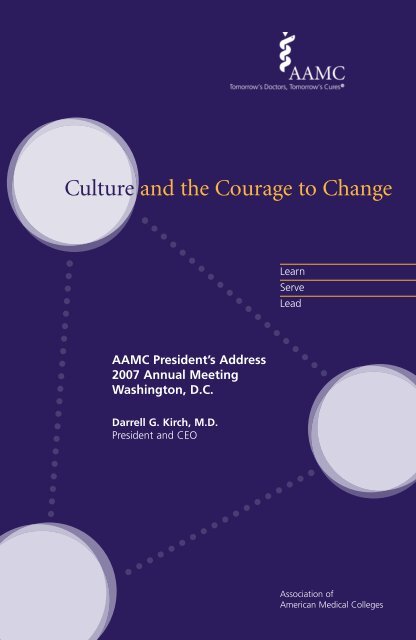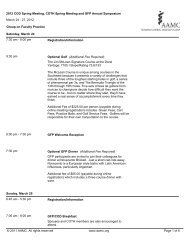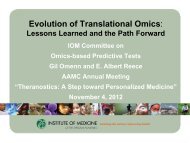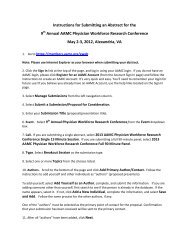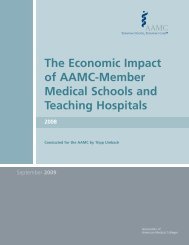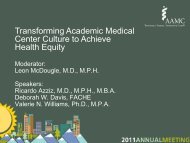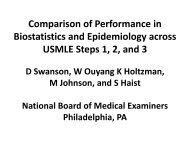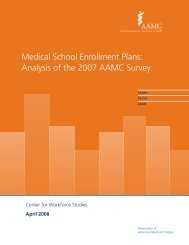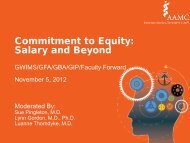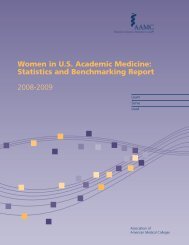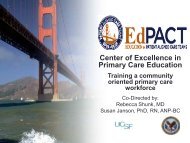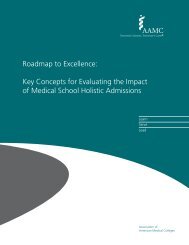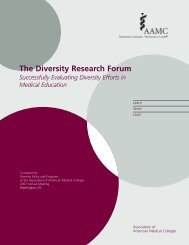Culture and the Courage to Change - Member Profile - AAMC
Culture and the Courage to Change - Member Profile - AAMC
Culture and the Courage to Change - Member Profile - AAMC
You also want an ePaper? Increase the reach of your titles
YUMPU automatically turns print PDFs into web optimized ePapers that Google loves.
<strong>Culture</strong> <strong>and</strong> <strong>the</strong> <strong>Courage</strong> <strong>to</strong> <strong>Change</strong>LearnServeLead<strong>AAMC</strong> President’s Address2007 Annual MeetingWashing<strong>to</strong>n, D.C.Darrell G. Kirch, M.D.President <strong>and</strong> CEOAssociation ofAmerican Medical Colleges
Darrell G. Kirch, M.D.,<strong>AAMC</strong> president <strong>and</strong> CEO, delivered his address, “<strong>Culture</strong> <strong>and</strong> <strong>the</strong> <strong>Courage</strong> <strong>to</strong><strong>Change</strong>,” at <strong>the</strong> <strong>AAMC</strong> annual meeting in Washing<strong>to</strong>n D.C., November 4, 2007.His remarks follow in essay form.© 2007 Association of American Medical Colleges
<strong>Culture</strong> <strong>and</strong> <strong>the</strong> <strong>Courage</strong> <strong>to</strong> <strong>Change</strong>Last year, when I had <strong>the</strong> honor of speaking <strong>to</strong> this group for <strong>the</strong>first time as your president, I was only beginning <strong>to</strong> appreciate<strong>the</strong> unique privilege it is <strong>to</strong> occupy this position. I must say thisfirst year has been an extraordinary experience for me. I have had <strong>the</strong>opportunity <strong>to</strong> cross <strong>the</strong> country several times, s<strong>to</strong>pping in over half<strong>the</strong> states <strong>to</strong> speak with various groups in our community, <strong>and</strong> <strong>to</strong> visitmany of our member schools <strong>and</strong> teaching hospitals. Most important,it has been a valuable opportunity <strong>to</strong> learn from all of you.I repeatedly have been impressed by your excellence <strong>and</strong> your accomplishments.I hope you <strong>and</strong> your colleagues take great pride in yourachievements. Whe<strong>the</strong>r it was a graduation ceremony, <strong>the</strong> opening ofa new facility, a faculty seminar on medical education, or an informallunch with students, I saw signs of progress everywhere <strong>and</strong> heardmany expressions of <strong>the</strong> passion for medicine that still runs deep <strong>and</strong>strong.On my visits, however, I also heard a strong undercurrent of deeplyconflicted feelings about our lives in academic medicine. Especiallyamong our front-line faculty colleagues, I frequently encounteredexpressions of great concern or even deep disillusionment regardingour ability <strong>to</strong> advance our core missions.These concerns were sometimes vague <strong>and</strong> sometimes focused onseemingly insurmountable problems, but at <strong>the</strong>ir core, <strong>the</strong>y seemedcentered on <strong>the</strong> ways our professional lives are changing. Frequently,<strong>the</strong>y were accompanied by a sense of great loss about “<strong>the</strong> way thingshave changed.” Strikingly, when I asked our colleagues why <strong>the</strong>y feltthis way, more often than not <strong>the</strong>ir answer reflected a perception that<strong>the</strong>re simply is not enough funding—as if more money could bringback “<strong>the</strong> way it used <strong>to</strong> be.”1Association of American Medical Colleges
<strong>Culture</strong> <strong>and</strong> <strong>the</strong> <strong>Courage</strong> <strong>to</strong> <strong>Change</strong>There is no doubt about it; we have become tightly focused on strategicallyincreasing <strong>the</strong> funding streams for our schools <strong>and</strong> academic healthsystems. We develop ambitious strategic plans <strong>to</strong> exp<strong>and</strong> our grant <strong>and</strong>contract portfolios. We build targeted clinical programs, often directed<strong>to</strong>ward high-end technology or cutting-edge procedures that have <strong>the</strong>corollary benefit of being “high margin” in reimbursement. We dramaticallyexp<strong>and</strong> our fund-raising staff in <strong>the</strong> hope of filling <strong>the</strong> wideninggap between our aspirations <strong>and</strong> our fiscal realities.I point this out not <strong>to</strong> disparage <strong>the</strong>se strategic activities. These planscertainly are relevant <strong>to</strong> our missions, <strong>and</strong> <strong>the</strong>y do generate betterfinancial margins. Everyone in academic medicine underst<strong>and</strong>s <strong>the</strong>principle of “no margin, no mission.”But is money really at <strong>the</strong> root of our discontent? I am not denying thatwe face serious challenges on <strong>the</strong> fiscal side. Whe<strong>the</strong>r it is <strong>the</strong> decreasedstate support seen by many public schools, <strong>the</strong> unprecedented flatteningin National Institutes of Health (NIH) funding, or all <strong>the</strong> familiarconstraints on clinical reimbursement, our institutions have experiencedreal downward pressure on <strong>the</strong>ir revenues.“There is no doubt about it; we have become tightlyfocused on strategically increasing <strong>the</strong> funding streamsfor our schools <strong>and</strong> academic health systems.”These financial pressures have generated <strong>the</strong> ambitious strategic initiativesI mentioned earlier, <strong>and</strong> collectively, <strong>the</strong>se initiatives have haddramatic results. Some key “vital signs” show <strong>the</strong> tremendous growththat academic medicine has experienced over <strong>the</strong> last 10 years. Totalannual revenues supporting our member U.S. medical schools haveincreased from $32 billion <strong>to</strong> nearly $71 billion. Annual funding fromfederal research grants <strong>and</strong> contracts has grown from almost $5.8 billion<strong>to</strong> just over $15 billion. Support from our teaching hospitals for medicalschool services <strong>and</strong> o<strong>the</strong>r programs has doubled from $4.8 billion <strong>to</strong>2Association of American Medical Colleges
<strong>Culture</strong> <strong>and</strong> <strong>the</strong> <strong>Courage</strong> <strong>to</strong> <strong>Change</strong>“I am dismayed by how often faculty members tellme that overall morale in <strong>the</strong>ir institutions, <strong>and</strong>especially <strong>the</strong>ir personal morale, is lower than ever.”over $9.6 billion. And <strong>to</strong> advance all <strong>the</strong>se missions, more than 28,000full-time faculty positions have been added nationally <strong>to</strong> U.S. medicalschools over <strong>the</strong> last 10 years. To be certain, this growth carries with itsubstantial additional obligations, <strong>and</strong> as a result, it should not be interpretedas an indication of margin or greater discretionary resources.However, <strong>the</strong> point is clear: we are growing. Interest in medicine as acareer remains strong as well. This year, a record number of nearly17,800 students began medical school, <strong>and</strong> <strong>the</strong> number of first-timeapplicants reached an all-time high of 32,000, confirming <strong>the</strong> findings ofa 2005 Gallup poll that <strong>the</strong> American public views being an M.D. as <strong>the</strong>“Most Desirable” profession a young person could pursue.But despite <strong>the</strong>se strong vital signs, many of us in academic medicinesimply do not seem <strong>to</strong> feel any better. I am dismayed by how oftenfaculty members tell me that overall morale in <strong>the</strong>ir institutions, <strong>and</strong>especially <strong>the</strong>ir personal morale, is lower than ever. And a recent<strong>AAMC</strong>-American Medical Association survey of faculty physicians overage 50 validated <strong>the</strong>se conversations by finding that nearly one-third feelless satisfied with <strong>the</strong>ir career in medicine than <strong>the</strong>y did three years ago.I have difficulty believing that <strong>the</strong> cause of this problem is as simple as “notenough money,” especially when you look at <strong>the</strong> 10-year pattern of stronggrowth I just described. Clearly, our strategic initiatives are bearing fruit.Increasingly, it appears <strong>to</strong> me that <strong>the</strong> source of our discontent is afundamental imbalance within our institutions—an imbalance thatstems from a failure <strong>to</strong> put at least as much energy in<strong>to</strong> improving ourculture as we put in<strong>to</strong> advancing our strategy.3Association of American Medical Colleges
<strong>Culture</strong> <strong>and</strong> <strong>the</strong> <strong>Courage</strong> <strong>to</strong> <strong>Change</strong>“Increasingly, it appears <strong>to</strong> me that <strong>the</strong> source ofour discontent is a fundamental imbalance withinour institutions—an imbalance that stems from afailure <strong>to</strong> put at least as much energy in<strong>to</strong> improvingour culture as we put in<strong>to</strong> advancing our strategy.”These days I find myself thinking about <strong>the</strong> frequently quoted saying,“<strong>Culture</strong> eats strategy for lunch every day.” There is a clear implicationfor us in <strong>the</strong> concept that culture is every bit as important as strategy.You can have a multivolume, exhaustively prepared strategic plan, but ifyou fail <strong>to</strong> attend <strong>to</strong> <strong>the</strong> culture of your organization, you may fail <strong>to</strong>reach any of your goals.If culture trumps strategy, perhaps we are suffering from how little effortwe explicitly devote <strong>to</strong> <strong>the</strong> culture of our own institutions. When we addup all <strong>the</strong> time we spend on developing strategic plans for our curriculum,clinical enterprise, <strong>and</strong> research programs, how does it compare <strong>to</strong> <strong>the</strong>time we spend on explicitly assessing <strong>and</strong> building <strong>the</strong> right kind ofculture? Is it a brilliant strategic plan that inspires faculty, staff, residents,<strong>and</strong> students, or is it a culture that makes <strong>the</strong>m feel fulfilled <strong>and</strong> valued? Ifyou look at our Web sites, you find that virtually every academic medicalcenter has an elegantly detailed strategic plan, but few seem <strong>to</strong> devote asmuch attention <strong>to</strong> <strong>the</strong> culture <strong>the</strong>y have or are trying <strong>to</strong> attain.Just what is <strong>the</strong> culture of an organization? Most definitions of culturefocus on <strong>the</strong> shared values, assumptions, norms, behaviors, <strong>and</strong> ritualsdeveloped by a group, as well as all <strong>the</strong> structures used <strong>to</strong> preserve <strong>the</strong>seessentials. While culture is an extraordinarily powerful force for a groupor organization, it is so pervasive <strong>and</strong> interwoven with every activity thatwe may not give it much conscious attention. However, when wedirectly examine our organizational culture, suddenly we can see clearly<strong>the</strong> drivers of performance, <strong>the</strong> reasons for levels of morale, <strong>and</strong> <strong>the</strong> rootcauses of many organizational conflicts <strong>and</strong> tensions. In turn, this4Association of American Medical Colleges
<strong>Culture</strong> <strong>and</strong> <strong>the</strong> <strong>Courage</strong> <strong>to</strong> <strong>Change</strong>examination presents <strong>the</strong> opportunity for us <strong>to</strong> change <strong>the</strong> culture ofour organization <strong>to</strong> improve performance, resolve conflicts, <strong>and</strong>, mostimportantly, help all of us feel genuinely fulfilled by our work.“While culture is an extraordinarily powerful forcefor a group or organization, it is so pervasive <strong>and</strong>interwoven with every activity that we may not giveit much conscious attention.”If culture matters so much, just what is our current culture in academicmedicine? The answer cannot be found simply by reciting our vision<strong>and</strong> mission statements. To underst<strong>and</strong> culture, we have <strong>to</strong> think aboutunderlying values, assumptions, norms, <strong>and</strong> rituals that are lessapparent. In his provocative book, The <strong>Culture</strong> Code, author ClotaireRapaille describes how a single code word or phrase often can capture<strong>the</strong> complex values, assumptions, <strong>and</strong> behaviors that make up a culture.As I was thinking about this <strong>to</strong>pic, I asked a number of colleagues which“code words” came <strong>to</strong> mind when <strong>the</strong>y reflected on <strong>the</strong> culture ofacademic medicine. Think about it yourself, <strong>and</strong> see if you agree withany of <strong>the</strong> feedback I received. What word would you choose <strong>to</strong>describe our prevailing culture in academic medicine? The descrip<strong>to</strong>rs Iheard included words like individualistic, au<strong>to</strong>nomous, scholarly, expertcentered,competitive, focused, high-achieving, <strong>and</strong> hierarchical.If those are <strong>the</strong> words that describe us, we could argue that <strong>the</strong>se culturecodes have served us well. There certainly is nothing wrong with generationsof medical students, residents, graduate students, <strong>and</strong> facultymembers aspiring <strong>to</strong> become scholarly experts. The competition ofclimbing <strong>the</strong> hierarchy of promotion <strong>and</strong> tenure may have helped pushgenerations of faculty members <strong>to</strong> great achievements. And certainly,<strong>the</strong> intense dedication of an award-winning lecturer, an internationallyrecognized clinician, or a Nobel-quality scientist is a wonder <strong>to</strong> behold.5Association of American Medical Colleges
<strong>Culture</strong> <strong>and</strong> <strong>the</strong> <strong>Courage</strong> <strong>to</strong> <strong>Change</strong>But we also need <strong>to</strong> be honest about how <strong>the</strong> culture of academicmedicine has led <strong>to</strong> some very specific behaviors <strong>and</strong> structures thatmay no longer serve us as well as <strong>the</strong>y did a decade or so ago, especiallygiven <strong>the</strong> future we face.“The descrip<strong>to</strong>rs I heard included words likeindividualistic, au<strong>to</strong>nomous, scholarly, expertcentered,competitive, focused, high-achieving,<strong>and</strong> hierarchical.”In education, generations of medical educa<strong>to</strong>rs have focused on <strong>the</strong>individual accumulation of factual knowledge. But is this <strong>the</strong> best way<strong>to</strong> create lifelong learners who have <strong>the</strong> skills <strong>to</strong> acquire <strong>and</strong> use dynamicallychanging <strong>and</strong> exponentially exp<strong>and</strong>ing information?On <strong>the</strong> research side, we have a his<strong>to</strong>ry of training researchers <strong>to</strong> achieve<strong>the</strong> status of independent investiga<strong>to</strong>rs, with <strong>the</strong> R01 st<strong>and</strong>ing asvalidation of <strong>the</strong>ir independence <strong>and</strong> expertise. But in a world ofincreasing research complexity, in which science is more <strong>and</strong> more interdisciplinary<strong>and</strong> highly networked, just how well does this model ofau<strong>to</strong>nomous investiga<strong>to</strong>rs work?In our clinical practices, despite <strong>the</strong> fact that <strong>the</strong>y have become hugehealth care delivery systems, we often persist in functioning like soloexpert specialists within <strong>the</strong>m. But how can a loose collection ofspecialized experts ever achieve <strong>the</strong> clinical <strong>and</strong> operational coordinationneeded <strong>to</strong> create a seamless system delivering patient-centered care?We have lived in a culture in which our medical schools, labora<strong>to</strong>ries,teaching hospitals, <strong>and</strong> faculty clinical practice plans often evolved asstructures designed first <strong>and</strong> foremost <strong>to</strong> support our au<strong>to</strong>nomouspursuits. Perhaps most tellingly, we have held tenaciously <strong>to</strong> <strong>the</strong> gr<strong>and</strong>tradition of rewarding <strong>the</strong> demonstration of combined independence<strong>and</strong> expertise with that treasured status of tenure, <strong>the</strong> <strong>to</strong>p rung of ourhierarchical professional ladder. And despite whatever struggles we6Association of American Medical Colleges
<strong>Culture</strong> <strong>and</strong> <strong>the</strong> <strong>Courage</strong> <strong>to</strong> <strong>Change</strong>experienced as individual faculty members, we affirmed this culture codeby taking enormous pride in our personal status as independent experts.If this culture of au<strong>to</strong>nomy <strong>and</strong> individual achievement worked so wellfor us, just what is causing <strong>the</strong> negative reactions—ranging from justunder-<strong>the</strong>-surface unease <strong>to</strong> downright disillusionment—that Iencounter so often when I talk with our faculty colleagues?My <strong>the</strong>ory is that we find ourselves in <strong>the</strong> middle of a major cultureclash. As we have grown our institutions—despite constraints in statesupport, NIH funding, <strong>and</strong> clinical reimbursement—we underst<strong>and</strong>ablyhave focused on strategies for generating new revenue while preservingour current structures <strong>and</strong> culture. But I would argue that, in doing so,we have failed <strong>to</strong> see how our changing environment is dem<strong>and</strong>ing thatwe adapt <strong>to</strong> a new, much different culture for academic medicine. Thereality is that, increasingly, <strong>the</strong> world around us is focused less on <strong>the</strong>achievements of individual experts, <strong>and</strong> more on collaboration betweenindividuals <strong>and</strong> groups <strong>to</strong> solve complex problems. The dilemma foracademic medicine may very well be that, while higher education <strong>and</strong>health care have held fast <strong>to</strong> <strong>the</strong>ir traditional individualistic culture, <strong>the</strong>world has fundamentally changed.“The reality is that, increasingly, <strong>the</strong> world aroundus is focused less on <strong>the</strong> achievements of individualexperts, <strong>and</strong> more on collaboration betweenindividuals <strong>and</strong> groups <strong>to</strong> solve complex problems.”The evidence for this change is all around. In research, consider <strong>the</strong> NIHClinical <strong>and</strong> Translational Science Awards <strong>and</strong> o<strong>the</strong>r programs with anemphasis on teams of highly networked scientists <strong>and</strong> <strong>the</strong> open sharingof information. In clinical care, whe<strong>the</strong>r <strong>the</strong> setting is <strong>the</strong> intensive careunit or a newly configured “medical home” delivering primary care, <strong>the</strong>driving concept is that patients want <strong>and</strong> need <strong>the</strong>ir ongoing care providedby a coordinated team, not a series of disconnected consultants. And in7Association of American Medical Colleges
<strong>Culture</strong> <strong>and</strong> <strong>the</strong> <strong>Courage</strong> <strong>to</strong> <strong>Change</strong>our core mission of education, we now underst<strong>and</strong> that attainingcompetence as a physician requires an integrated learning continuum,not a discontinuous assortment of independent lectures <strong>and</strong> tests.The code words of this new culture of academic medicine are verydifferent. When I asked my colleagues <strong>to</strong> think of single words or phrasescapturing what our culture code needs <strong>to</strong> be, <strong>the</strong>y offered descrip<strong>to</strong>rs likecollaborative, transparent, outcomes-focused, mutually accountable, teambased,service-oriented, <strong>and</strong> patient-centered. To put it in simplest terms,when most of us entered academic medicine, it was all about achievingyour “personal best.” Now it has become <strong>the</strong> quintessential “team effort.”If culture is made up of <strong>the</strong> complex web of values, assumptions, norms,behaviors, <strong>and</strong> rituals pervading an organization, a major change in culturecan be wrenching, <strong>to</strong> say <strong>the</strong> least. Increasingly, I believe that <strong>the</strong> root causeof much of <strong>the</strong> discontent heard in academic medicine is a direct expressionof <strong>the</strong> dislocation we are experiencing in trying <strong>to</strong> move from a culturefocused on au<strong>to</strong>nomy, competition, <strong>and</strong> individual achievement <strong>to</strong> one thatvalues collaboration, shared accountability, <strong>and</strong> team performance.“...our culture code needs <strong>to</strong> be...collaborative,transparent, outcomes-focused, mutually accountable,team-based, service-oriented, <strong>and</strong> patient-centered.”Imagine <strong>the</strong> reaction of a faculty member who started his or her careerfocused intensely on personal achievement <strong>and</strong> building an impressivecurriculum vitae, but who now finds that <strong>the</strong> emphasis has shifted <strong>to</strong>being a collaborative component of a research network? What about <strong>the</strong>teachers who no longer feel that <strong>the</strong>y each have a personal set of lecturesthat <strong>the</strong>y independently “own?” Imagine being a department chairgoing from a world in which <strong>the</strong> individual departments <strong>and</strong> sectionsare independent boats expected <strong>to</strong> float on <strong>the</strong>ir own financial bot<strong>to</strong>ms,<strong>to</strong> a world in which <strong>the</strong> finances of <strong>the</strong> entire center are open information<strong>and</strong> managed as an integrated whole. How does it feel when8Association of American Medical Colleges
<strong>Culture</strong> <strong>and</strong> <strong>the</strong> <strong>Courage</strong> <strong>to</strong> <strong>Change</strong>“Just as it requires courage <strong>to</strong> leave one country<strong>and</strong> emigrate <strong>to</strong> a new one, it is going <strong>to</strong> takecourage for all of us in academic medicine, asindividuals <strong>and</strong> as institutions, <strong>to</strong> embrace ournew culture.”core organizational values change from competition <strong>to</strong> collaboration,from au<strong>to</strong>nomy <strong>to</strong> interdependence, from private focus <strong>to</strong> transparency<strong>and</strong> sharing of information <strong>and</strong> resources, from personal control <strong>to</strong>trusting one ano<strong>the</strong>r? For many of our colleagues in academicmedicine, it must feel bewildering, like <strong>the</strong> rules have changed in <strong>the</strong>middle of <strong>the</strong> game. In that light, it becomes much easier <strong>to</strong> underst<strong>and</strong><strong>the</strong> distress so many of our colleagues express. They entered a world ofacademic medicine built around one culture, <strong>and</strong> now are asked <strong>to</strong>embrace a very different culture. No wonder so many of us express adesire <strong>to</strong> return <strong>to</strong> <strong>the</strong> “good old days.”This is where we come <strong>to</strong> courage. Just as it requires courage <strong>to</strong> leaveone country <strong>and</strong> emigrate <strong>to</strong> a new one, it is going <strong>to</strong> take courage for allof us in academic medicine, as individuals <strong>and</strong> as institutions, <strong>to</strong>embrace our new culture.While any change of this magnitude can be expected <strong>to</strong> engender a realsense of loss, <strong>the</strong>re are three facts in which we can take great comfort.First, this change in culture is not only possible, it is actually wellunderway at many of our institutions. Second, we should realize <strong>the</strong>potential for enormous personal fulfillment in a new kind of culture.Last, <strong>and</strong> most important, we do not have <strong>to</strong> ab<strong>and</strong>on every element of<strong>the</strong> traditional culture of academic medicine. In fact, we should fight <strong>to</strong>retain our commitment <strong>to</strong> overall excellence, even as we shift fromdoing this as individuals <strong>to</strong> doing so in a new collaborative context.Excellence is excellence, regardless of how we get <strong>the</strong>re.9Association of American Medical Colleges
<strong>Culture</strong> <strong>and</strong> <strong>the</strong> <strong>Courage</strong> <strong>to</strong> <strong>Change</strong><strong>the</strong>se entities. The magic lies in taking <strong>the</strong> time <strong>to</strong> build <strong>the</strong> relationshipsthat establish high levels of communication <strong>and</strong> trust.Ano<strong>the</strong>r important <strong>to</strong>ol <strong>to</strong> create a new culture is <strong>the</strong> redesign of ourrewards systems so that <strong>the</strong>y emphasize group contributions as much aspersonal achievements.This new culture also requires a different kind of leader. Chairs,direc<strong>to</strong>rs, health system leaders, <strong>and</strong> deans will need <strong>to</strong> be selected asmuch or more for <strong>the</strong>ir group skills than for <strong>the</strong>ir individual accomplishments.This means search committees will need <strong>to</strong> look far beyond<strong>the</strong> weight of a c<strong>and</strong>idate’s curriculum vitae, considering fac<strong>to</strong>rs such as<strong>the</strong>ir ability <strong>to</strong> build alignments, foster trust, <strong>and</strong> make adaptive changes.Looking <strong>to</strong> <strong>the</strong> future, we need <strong>to</strong> acknowledge that this new culture alsowill dem<strong>and</strong> that we rethink whom we select for admission <strong>to</strong> medicalschool. What admissions criteria can best attract students who not onlyare firmly grounded in <strong>the</strong> scientific foundation of medicine, but alsoembrace <strong>the</strong> qualities of <strong>the</strong> new culture?While by no means an exhaustive list, <strong>the</strong>se steps are all within our reach,<strong>and</strong> many already are being pursued by our colleagues around <strong>the</strong> country.As leaders of your institutions, I urge you <strong>to</strong> support <strong>and</strong> speed thisfundamental culture change for academic medicine. If we have <strong>the</strong>courage <strong>to</strong> embrace this change, I am confident that a renewed level ofgratification in all our key missions will follow.As educa<strong>to</strong>rs, we will experience <strong>the</strong> excitement of making our teachingtruly about integrated lifelong learning.As scientists, we will realize our true potential through collaborativeefforts such as <strong>the</strong> integrated translational research networks now beingbuilt based on our new genomic knowledge.And our patients, who in many ways st<strong>and</strong> <strong>to</strong> gain <strong>the</strong> most from thischange, will benefit by having academic medicine create real “medical11Association of American Medical Colleges
<strong>Culture</strong> <strong>and</strong> <strong>the</strong> <strong>Courage</strong> <strong>to</strong> <strong>Change</strong>homes” for <strong>the</strong>m, from which <strong>the</strong>y can receive true continuity of care.We can finally solve <strong>the</strong> problem that, despite all our knowledge, <strong>to</strong>omany patients have been left “medically homeless” by our expertcenteredsystem focused on acute episodic care.In his book, The <strong>Courage</strong> <strong>to</strong> Teach, Parker Palmer talks about <strong>the</strong> pricewe pay when we feel a deep internal division between what we know weshould do <strong>and</strong> what we actually do in practice. He talks about <strong>the</strong> gratificationthat comes from being what he calls, “divided no more.” I thinkwe all have felt distressed by <strong>the</strong> gap between what we actually have beendoing in practice <strong>and</strong> <strong>the</strong> patient-centered care we know we shoulddeliver. This is our own opportunity <strong>to</strong> be “divided no more.”We have <strong>the</strong> possibility of creating a much more meaningful <strong>and</strong> gratifyingculture for our faculty, staff, <strong>and</strong> learners, <strong>and</strong> especially for <strong>the</strong>patients we have committed <strong>to</strong> serve. A culture that is grounded in <strong>the</strong>values of collaboration, trust, <strong>and</strong> shared accountability. A culture that isreinforced through team-based structures <strong>and</strong> shared reward systems. Aculture that encourages transparency <strong>and</strong> inclusivity, ra<strong>the</strong>r than exclusivity.A culture that is driven equally by our traditional commitment <strong>to</strong>excellence, <strong>and</strong> by service <strong>to</strong> o<strong>the</strong>rs. A culture in which all learn <strong>and</strong> allteach, <strong>and</strong> all experience great fulfillment in <strong>the</strong> process.I fundamentally believe that this is an opportunity for us <strong>to</strong> recapture someof <strong>the</strong> professional excitement that brought us <strong>to</strong> academic medicine in <strong>the</strong>first place. By underst<strong>and</strong>ing <strong>the</strong> positive potential in this new culture, wecan regain that sense of optimism so many of us seem <strong>to</strong> have lost.Underst<strong>and</strong>ing our culture <strong>and</strong> working <strong>to</strong> change it <strong>to</strong> better fit <strong>the</strong> world wenow face is a choice we can make. Certainly courage will be required, but wemight do well <strong>to</strong> remember <strong>the</strong> words of a great man who taught us about“profiles in courage.” President John F. Kennedy once said,“<strong>Change</strong> is <strong>the</strong> lawof life. And those who look only <strong>to</strong> <strong>the</strong> past or present are certain <strong>to</strong> miss <strong>the</strong>future.” Now it is our choice about whe<strong>the</strong>r we long for <strong>the</strong> past, or turn ourattention <strong>to</strong> building <strong>the</strong> culture of <strong>the</strong> future for academic medicine.Thank you for <strong>the</strong> opportunity <strong>to</strong> share my thoughts with you <strong>to</strong>day.12Association of American Medical Colleges
Association ofAmerican Medical Colleges2450 N Street, N.W., Washing<strong>to</strong>n, D.C. 20037-1127T 202 828 0400 F 202 828 1125www.aamc.org


